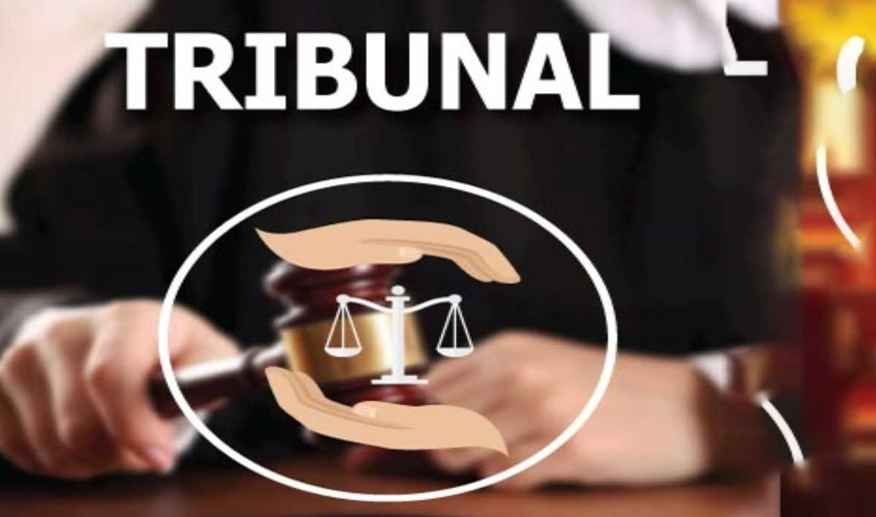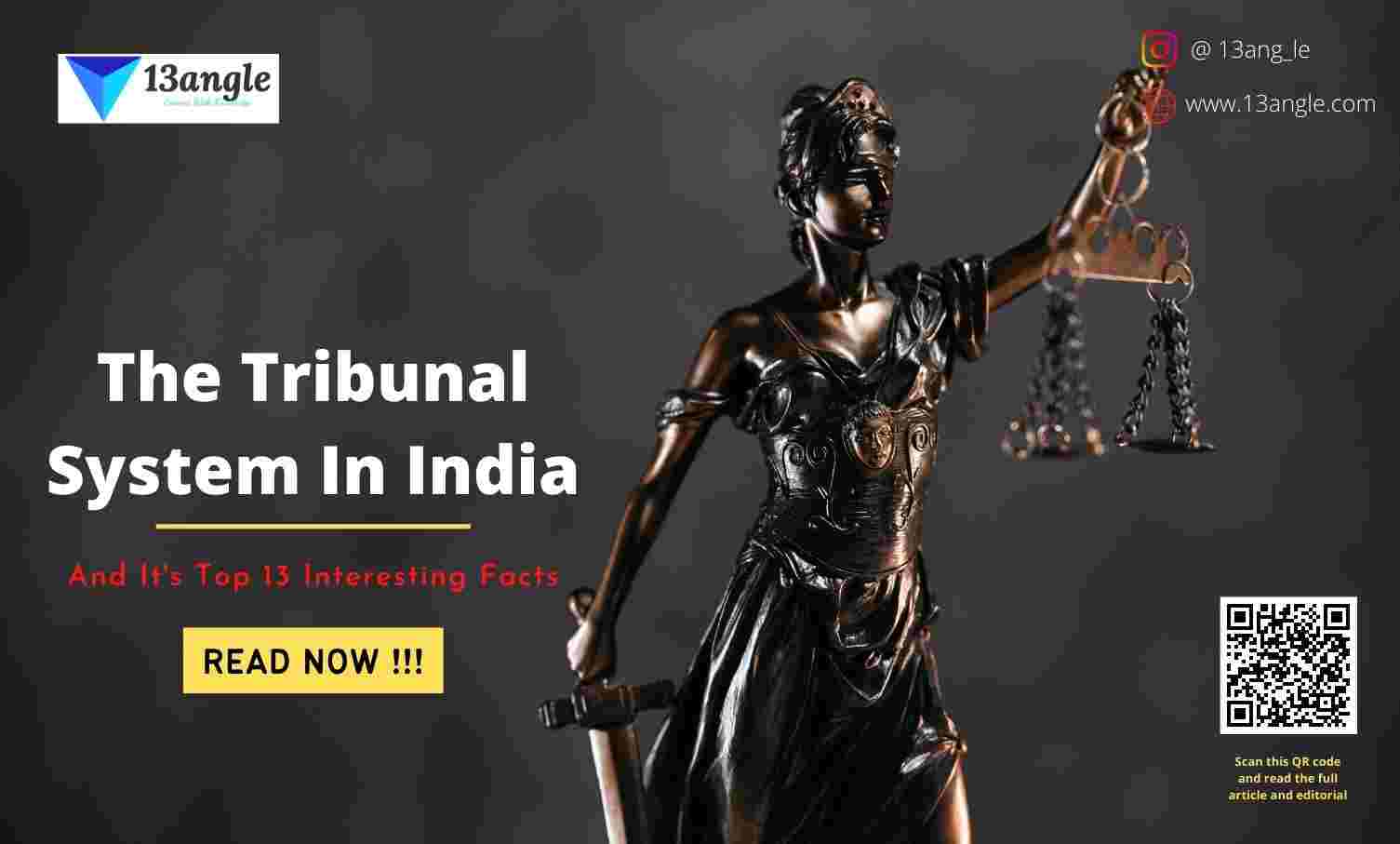- Umang Sagar
- Law, Polity, Recent article
The Tribunal System In India

Introduction
Tribunal is a quasi-judicial organization created to handle issues like settling administrative or tax-related disagreements. It carries out several tasks, including adjudicating disputes, deciding the rights of disputing parties, making administrative decisions, reviewing past administrative decisions, and more. The word “Tribunal,” which means “Magistrates of the Classical Roman Republic,” is derived from the word “Tribunes.”
The term “Tribunal” refers to the position of the “Tribunes,” a Roman official serving in both the monarchy and the republic who was responsible for defending the populace from the arbitrary actions of the aristocrat magistrates. A tribunal, whether or not it has the word “tribunal” in its name, is, in general, any person or entity with the power to judge, rule on, or resolve claims or disputes.
Structure Of Indian Tribunal System

- The tribunal system has developed as a substitute for the traditional court system over the last eighty years. The Income Tax Appellate Tribunal was created in 1941 to reduce the pendency of cases in courts. After the inclusion of 323A and 323B, various tribunals such as Central Administrative tribunals and sector-specific tribunals were set up from the 1980s to the 2010s. The introduction of the Finance Act, of 2017 consolidated several tribunals in India. In 2021, a bill has been introduced that abolished nine tribunals and transferred the matter to the courts.
Key Developments In The Indian Tribunal System

YEAR | KEY DEVELOPMENTS |
1941 | The first tribunal in India was founded, and its name is the Income Tax Appellate Tribunal. The goal was to lighten the burden on courts, speed up dispute resolution, and increase the Tribunal’s capacity for tax-related issues. |
1969 | The establishment of Civil Services Tribunals at the federal and state levels was advised by the First Administrative Reforms Commission. These Tribunals would serve as the last line of defence for decisions regarding the dismissal, expulsion from service, and rank reduction of federal workers. |
1974 | A separate, powerful tribunal and commission should be established, according to the Sixth Law Commission (1974), to decide cases brought before the High Courts. This was done to get cases out of the High Courts’ backlog. |
1976 | a) The Swaran Singh Committee (1976) found that public employees frequently brought service complaints before the High Courts. It advocated for the creation of I administrative tribunals (at the national and state levels) to rule on disputes involving working conditions; (ii) an all-India appeals tribunal to hear cases from labor courts and industrial tribunals; and (iii) tribunals to hear disputes pertaining to different industries (such as revenue, land reforms, and essential commodities). Additionally, it was advised that the Supreme Court should review the tribunals’ rulings. |
| b) The Constitution’s 42nd amendment was approved. The amendment gave Parliament the authority to establish I administrative tribunals (at the federal and state levels) to decide on issues pertaining to public employee hiring and working conditions; and (ii) other tribunals to decide on issues pertaining to labor disputes, taxation (such as the levy and collection of taxes), and foreign exchange. |
Since the | a) Different Acts created several tribunals. |
1980s | b) Among them are the Central Administrative Tribunal for administrative disputes, the Securities Appellate Tribunal to hear appeals against financial sector regulators’ rulings, and an Appellate Tribunal where the Central Film Certification Board’s rulings could be contested, and an Appellate Tribunal for Electricity to hear tariff disputes. |
2017 | Based on functional similarity, the Finance Act of 2017 reorganized the tribunal system by integrating similar-functioning tribunals. Tribunals were whittled down from 26 to 19. It gave the central government the authority to select, remove, and set the terms of service for these tribunals’ chairs and members by creating rules in this regard. |
2021 | In February, the Lok Sabha received the Tribunals Reforms (Rationalization and Conditions of Service) Bill, 2021. At the end of the session, the Bill was still pending, thus an ordinance containing comparable clauses was published in April 2021. Nine tribunals are disbanded, and their duties are transferred to other judicial organizations (mainly High Courts). |
Key Judgements Related To Tribunals In India

SUPREME COURT JUDGEMENT | PRINCIPLES SPECIFIED |
S.P. SAMPATH KUMAR VS UNION OF INDIA, 1968 | a) Constitutionally speaking, Parliament may establish a different institution to serve as a judge in some cases, if the new institution has the same authority as the High Court. These tribunals will be regarded as the High Courts’ replacements. |
| b) The Central Government of India, in conjunction with the Chief Justice of India, or a high-powered selection committee presided over by the Chief Justice of India, a sitting judge of the Supreme Court, or a sitting judge of the relevant High Court, should appoint candidates. |
CHANDRA KUMAR VS UNION OF INDIA, 1997 | a) To relieve the pressure on High Courts, a tribunal that serves as a stand-in institutional mechanism for judicial review must have the standing of a High Court. |
| b) These tribunals will serve as courts of the first instance in the legal disciplines for which they were established. However, a division bench of the High Court under whose jurisdiction the concerned tribunal falls will review the decisions of these tribunals. |
| c) Any weighting in favor of non-judicial members would make a tribunal that stands in for a High Court less effective and powerful than the High Court. |
| d) The only people who should be appointed to tribunals have judicial experience. |
Constitutional Foundation And Competence Of Tribunals
Tribunals’ constitutional legitimacy has been contested. whether the Supreme Court’s and High Courts’ authority can be altered. The Supreme Court declared in 1986 that Parliament may establish a High Court substitute if it has equal authority as the High Courts.
The Supreme Court declared in 1997 that these Tribunals might make decisions about the constitutionality of statutory provisions.
They will, however, be regarded as an addition to high courts rather than as a replacement in such cases. A division bench of the High Court may therefore review their decisions on these issues. In addition, the Supreme Court ruled that tribunals are not permitted to rule on issues pertaining to the parent statutes’ validity. These issues need to be adjudicated directly by courts.
Advantages Of Tribunals
Expertise- The fact that people in control of the system are typically professionals is one of the main advantages of tribunals over traditional court systems. Tribunals are specialized courts made up of professionals from various fields. This gives it the ability to hear any case, including those involving medicine, law, or engineering. As an example, a court may be dealing with a technical and scientific issue. Because of this, the judge finds it challenging to preside over such cases because his area of expertise is law rather than science. Therefore, efforts are undertaken to construct a tribunal that will handle such unusual issues rather than suggesting that judges should specialize in handling particular matters. In most cases, this is the reason a tribunal is chosen in a case.
Cost Effectiveness- The tribunal system has several benefits over the traditional court system, including the fact that it is less expensive. Nobody enjoys shelling out a lot of money to file cases in court; instead, they favor using a tribunal. In contrast to ordinary courts, administrative tribunal proceedings are frequently quite affordable. Both the litigant’s viewpoint and the administrative authority’s vantage point are used to observe this.
Flexible- Numerous legal writers and scholars have supported the idea that while tribunals are not required to abide by any rules, they often render incorrect decisions in legal cases because they are required to follow certain rules (such as the rules of evidence and process). One benefit it has over the legal system is this. Tribunals are not required to abide by the rules of procedure and evidence, nor are they constrained by the concepts of stare decisis. This allows the system to be flexible. In common law courts, the situation is always the opposite.
Informality Of Proceedings- A tribunal’s hearings are typically informal, without the formalities of pleadings, wigs, and other courtroom attire that are part of ordinary court procedures. Justice and fact-finding are made simple as a result. It is intended to give the average person a sense of comfort and enable him to completely fulfill his expected role as required by the justice of the individual case. In fact, this is another benefit of tribunal systems over courts.
Disadvantages Of Tribunals
Inadequate Legal Knowledge- Most of the time, tribunal members lack the necessary legal expertise and fact-finding skills since they have not received the appropriate training. They use assessors because of this, which may result in injustice. In a judicial system with judges who have undergone extensive training, the situation is different. Evidently, this is a valid argument against constantly using the tribunal system for legal disputes. It is a significant drawback of an administrative tribunal.
Inadequate Observance Of Legal Procedure- Judicial precedent, which ensures legal consistency, is one of the court system’s outstanding features. Tribunals, however, are not constrained by the judicial precedent or the standards of evidence and procedure. As a result, they frequently make decisions without having enough evidence for each. Because of this, some scholars believe that the tribunal system should be abolished. Naturally, this is another drawback of tribunals versus traditional courts.
Lack Of Fair Hearing And Non – Observance Of The Principle Of Natural Justice- Parties in the tribunal system frequently do not receive a fair hearing. This clearly violates the principle of natural justice, one of the most important fundamental rights of citizens. The tribunal system also violates the second pillar of natural justice, which states that both sides should be heard in every case so that a conviction or finding of guilt cannot be obtained based on biased evidence or testimony.
Difference Between Court And Tribunals
TRIBUNALS | COURTS |
1. It is an organization established by statute and endowed with judicial authority. | 1. The conventional judicial system includes courts, whose authority is derived from the State. |
2. Tribunals give awards. | 2. A judgment, decree, conviction, or acquittal is issued by courts. |
3. The executive has complete control over the length of service, terms of employment, and other circumstances for tribunal members. | 3. Court judges are apart from the executive. |
4. Tribunals must abide by natural justice principles, not civil procedure rules. | 4. All norms of process and evidence must be followed by courts of law. |
5. They work on particular cases. | 5. They handle a range of cases. |
Independence Of Tribunals
- The Supreme Court stated in 2010 that India’s tribunals still lacked complete independence. When examining the National Tax Tribunal Act, 2005 in 2014, the Supreme Court ruled that a tribunal must be free from executive interference if it is given High Court jurisdiction. Any central government intervention in the administration of tribunals (such as approving member leave) would compromise their independence. The following factors affect the independence of tribunals:
- the process used to choose the members,
- the makeup of the tribunals, and
- the members’ tenure of office and working conditions.
1. Selection Process Of Members- The Supreme Court stated that the complete separation of the judiciary from all types of influence from the government is a basic necessary characteristic of the Constitution in 1986 while considering the Administrative Tribunal Act, 1985. Thus, it breaches the independence of the judiciary to allow the central government to choose the Chairperson and other members of a Tribunal that was constituted to act in place of a High Court. The Supreme Court reaffirmed in 2019 that the theory of the separation of powers is violated and that the absence of judicial control in the selection committees of tribunals is an invasion of the judicial domain. The Court further explained that because the Executive is frequently a party to disputes, it should not be permitted to have undue influence over decisions regarding judicial appointments.
- In November 2020, the Court mandated that the selection committees of tribunals should be made up of the following individuals:
- the Chief Justice of India or his nominee (with a casting vote).
- the tribunal’s presiding officer; or
- a retired Supreme Court judge or Chief Justice of High Court if the tribunal’s presiding officer is not a judicial member or if he is seeking reappointment); and The Ministry of Law and Justice Secretary, the Secretary from the Parent Ministry, the Secretary from the Non-Parent Ministry, and the Secretary to the Central Government (without a vote).
2. Composition Of Tribunals- According to the Supreme Court, a tribunal’s members may be chosen from among several different disciplines of competence as well as departments of the federal government. One important aspect of tribunals that sets them apart from ordinary courts is the participation of expert members (technical members) in addition to judicial members. Only those having a judicial background (such as High Court Judges and attorneys who meet the requirements and are qualified for appointment as High Court Judges) may be taken into consideration for appointment as Judicial Member.
Top 13 Facts About The Tribunal System In India
Tribunals are organizations created to carry out judicial or quasi-judicial functions. The goal can be to lighten the judiciary’s caseload or to bring in subject matter experts for complex issues.
The Supreme Court has declared that tribunals should have the same amount of independence from the administration as the judiciary because they are quasi-judicial entities. The method of member selection, the make-up of tribunals, and the length of service are important considerations.
With effect from 1st June 2016, the National Company Law Appellate Tribunal (NCLAT) was established under Section 410 of the Companies Act, 2013 to hear appeals against the decisions of the National Company Law Tribunal(s). In India, there are 14 tribunals.
The Tribunals, Courts and Enforcement Act became effective on November 3, 2008.
Tribunals are typically created to offer a quicker, more affordable, and less formal mechanism for resolving disputes between individuals.
The Central Administrative Tribunal, Income Tax Appellate Tribunal, Customs, Excise and Service Tax Appellate Tribunal, National Green Tribunal, Competition Appellate Tribunal, and Securities Appellate Tribunal are just a few of the tribunals that deal with administrative and tax-related disputes.
Tribunals are not authorized by the constitution. Through the 42nd Amendment, Articles 323A and 323B were added to the Indian Constitution in 1976.
They lack the authority to carry out their own judgments.
Tribunals are given their authority either directly by the laws that enable them or indirectly by laws that are generally applicable to the tribunal process.
The NCAT’s decision-makers are the Tribunal Members. According to the law and the supplied facts, they hear cases and render decisions.
A tribunal appeal cannot be filed without paying any fees or other costs. The appeals process is intended to be free and not to deter people from appealing out of a concern for incurring fees and expenditures.
In India, there are numerous tribunals. There are 17 Benches among the Central Administrative Tribunals.
Compared to the regular court system, administrative tribunals are designed to be less formal, less expensive, and have a speedier means to resolve disputes.

For deep details, you can read the full article. Click the link below :



